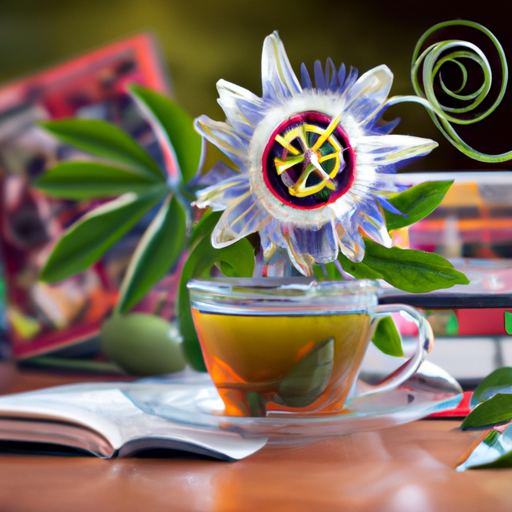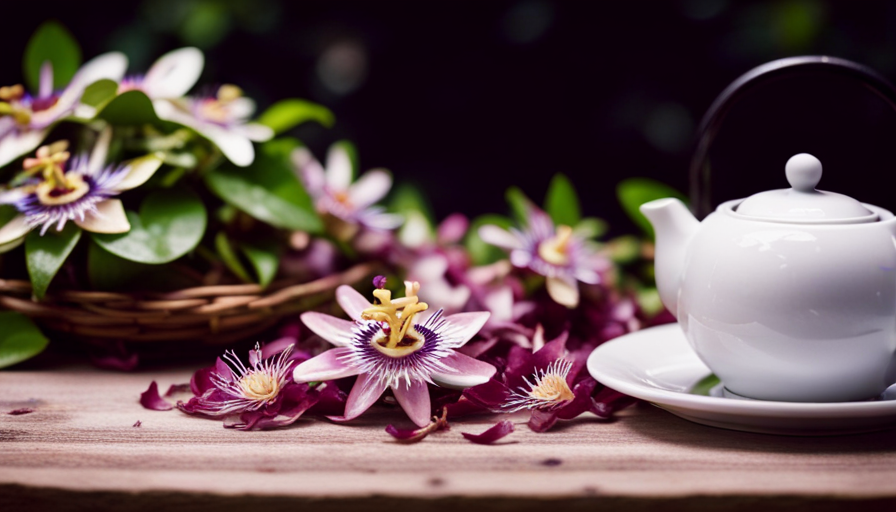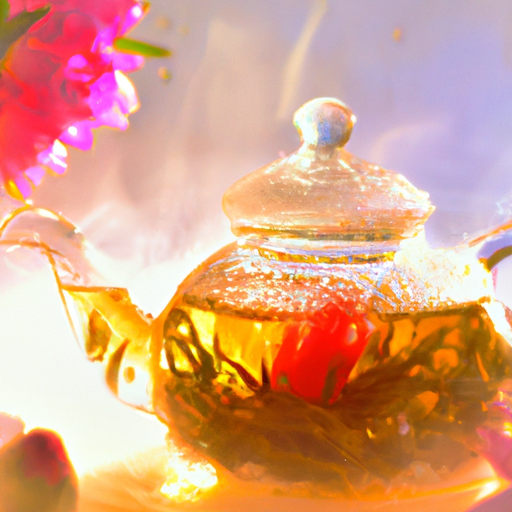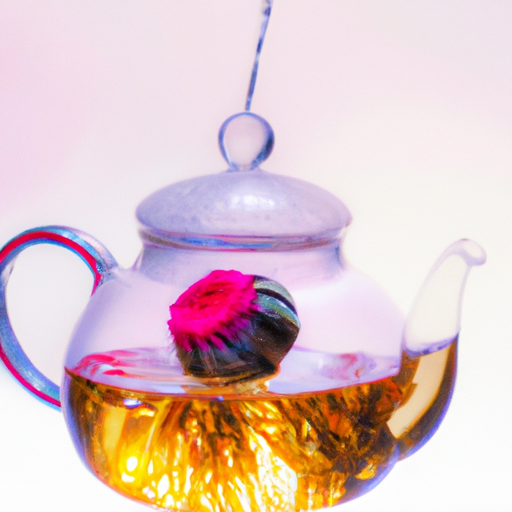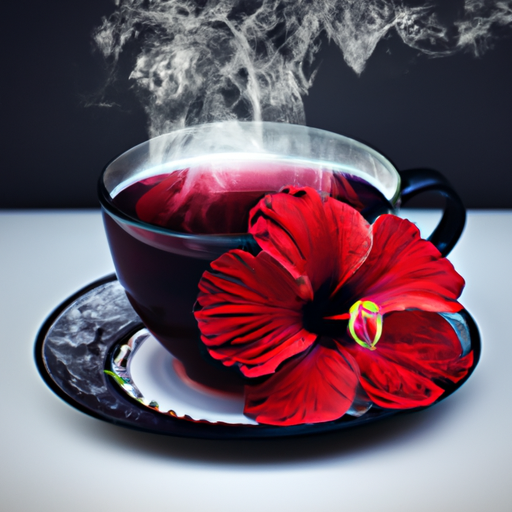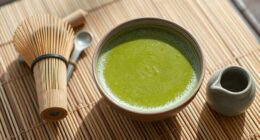Have you ever come across a tea that not only mesmerizes you with its vibrant blue hue but also tantalizes your taste buds with its unique flavor? That’s exactly what butterfly pea flower tea does.
I first discovered this captivating brew during my visit to Thailand, where it is a beloved traditional drink. As I sipped on a steaming cup, I was immediately struck by its delicate floral notes and subtle earthy undertones. The taste was unlike anything I had experienced before, a harmonious blend of sweetness and herbal essence.
Intrigued, I delved deeper into the world of butterfly pea flower tea to uncover its origins, brewing techniques, and health benefits. In this article, we will explore the fascinating taste profile of this enchanting tea and discover why it has gained popularity worldwide.
So, join me on this flavorful journey as we unravel the secrets of butterfly pea flower tea.
Key Takeaways
- Delicate floral notes and subtle earthy undertones
- Slight sweetness balances out earthiness
- Refreshing with floral notes
- Enhances taste and appearance of cocktails, mocktails, and desserts
Origins and Cultivation of Butterfly Pea Flowers
Did you know that butterfly pea flowers, which are the main ingredient in butterfly pea flower tea, have been cultivated in Southeast Asia for centuries? These vibrant blue flowers, scientifically known as Clitoria ternatea, are native to this region and have been used for various purposes throughout history.
Butterfly pea flower tea is made by steeping the dried flowers in hot water, which releases their natural blue pigment and imparts a delicate floral flavor to the drink. This unique tea has gained popularity not only for its refreshing taste but also for its numerous health benefits. Rich in antioxidants, butterfly pea flower tea is believed to have anti-inflammatory properties and can help boost the immune system. It’s also known to promote healthy hair and skin, as well as improve digestion.
In addition to its health benefits, butterfly pea flower tea is also valued for its versatility. It can be enjoyed both hot and cold, and its vibrant blue color makes it a popular choice for cocktails and other beverages.
Now that you know about the origins and benefits of butterfly pea flowers, let’s explore the various brewing methods and preparation techniques to make the perfect cup of butterfly pea flower tea.
Brewing Methods and Preparation Techniques
To brew butterfly pea flower tea, you’ll want to steep the dried petals in hot water for around 5 minutes, resulting in a vibrant blue hue that changes to purple when lemon juice is added. Here are some brewing techniques and preparation tips to help you make the perfect cup of butterfly pea flower tea:
- Water temperature: Use boiling water to extract the full flavor and color of the petals.nn2. Steeping time: Allow the petals to steep for 5 minutes to release their natural pigments and delicate floral flavors.nn3. Tea to water ratio: Use 1 teaspoon of dried petals for every 8 ounces of water to achieve a balanced brew.nn4. Infusion method: Place the petals in a teapot or infuser, pour hot water over them, and let them steep.
Once you’ve followed these steps, you’ll be greeted with a mesmerizing blue liquid that’s both visually stunning and aromatic. The delicate aroma of butterfly pea flower tea is reminiscent of fresh flowers, with a subtle earthy undertone.
In the next section, we’ll explore the appearance and aroma of butterfly pea flower tea in more detail.
Appearance and Aroma of Butterfly Pea Flower Tea
When you brew butterfly pea flower tea, the resulting liquid is a captivating shade of blue that transforms into a beautiful purple with the addition of lemon juice, creating a visual spectacle that is as enchanting as it is delicious. The appearance of this tea is truly remarkable, making it a popular choice for those looking to add a touch of magic to their tea-drinking experience.
Not only does butterfly pea flower tea have color-changing properties, but it also has a delightful aroma that further enhances its allure. The scent is delicate and floral, with hints of earthiness and a subtle sweetness. It is truly a treat for the senses.
To emphasize the color-changing properties of butterfly pea flower tea, consider this table:
| Color Before | Color After |
|---|---|
| Blue | Purple |
This table showcases how the tea undergoes a stunning transformation, adding to its visual appeal.
In addition to its captivating appearance and aroma, butterfly pea flower tea also has the unique ability to blend well with other teas and ingredients. Its mild flavor allows it to be easily paired with different types of tea, such as green tea or black tea, creating endless possibilities for tea blending enthusiasts.
As we delve into the flavor profile and taste notes of butterfly pea flower tea, we will discover the true magic behind this enchanting beverage.
Flavor Profile and Taste Notes
When it comes to the flavor profile of butterfly pea flower tea, there are a few key points to note. First, it has earthy undertones that add depth and richness to the overall taste.
Second, there’s a slight sweetness that balances out the earthiness and adds a pleasant touch.
Lastly, the tea has floral and refreshing notes that make it a truly delightful and invigorating drink.
Earthy Undertones
The earthy undertones of butterfly pea flower tea add a subtle complexity to its overall flavor profile. This unique tea has an earthy flavor that’s reminiscent of the natural surroundings in which the butterfly pea plant grows. The herbal infusion of the butterfly pea flower creates a soothing and grounding experience for the senses.
When sipping on a cup of butterfly pea flower tea, you can expect to taste hints of earthiness that are both comforting and refreshing. The earthy undertones provide a sense of connection to nature, allowing you to feel more grounded and centered.
As we transition to the next section about the slight sweetness of butterfly pea flower tea, you’ll discover how these earthy notes perfectly balance with a touch of sweetness.
Slight Sweetness
Get ready to indulge in a cup of butterfly pea flower tea that offers a delightful touch of sweetness to tantalize your taste buds. This unique herbal tea, derived from the vibrant blue petals of the butterfly pea flower, boasts a flavor profile that is both intriguing and satisfying.
The slight sweetness of this tea adds a pleasant dimension to its earthy undertones, creating a well-balanced and enjoyable experience for the palate. As you take your first sip, you’ll be greeted by a gentle sweetness that lingers on your tongue, complementing the natural flavors of the butterfly pea flower.
This tea is truly a treat for those seeking a beverage that combines the earthiness of herbal tea with a hint of sweetness. And now, let’s explore the floral and refreshing notes that await us in the next section.
Floral and Refreshing Notes
Indulge in a cup of this magical brew and let the delightful floral and refreshing notes transport you to a whimsical garden of flavors. Butterfly pea flower tea has a unique taste that’s both floral and refreshing, making it a truly delightful experience for the senses.
The flavor is subtle yet distinct, with hints of earthiness and a touch of sweetness. It pairs well with citrus fruits like lemon or lime, which enhance its vibrant blue color and add a tangy twist to the taste.
One of the most fascinating aspects of this tea is its color-changing properties. When lemon juice is added, the blue tea turns into a mesmerizing purple hue, creating a visually stunning drink.
Now, let’s delve into the next section and explore the health benefits and nutritional value of butterfly pea flower tea.
Health Benefits and Nutritional Value
Discover the amazing health benefits and impressive nutritional value of butterfly pea flower tea – it’s a natural way to boost your well-being and nourish your body! This vibrant blue tea isn’t just visually stunning, but it’s also packed with beneficial properties.
Here are three reasons why you should consider adding butterfly pea flower tea to your daily routine:
-
Rich in antioxidants: Butterfly pea flower tea is a powerhouse of antioxidants, which help protect your body against harmful free radicals and reduce the risk of chronic diseases. These antioxidants also have anti-inflammatory properties, promoting a healthier immune system.
-
Supports brain health: The tea contains flavonoids that can enhance brain function and improve cognitive abilities. Regular consumption of butterfly pea flower tea may help improve memory, focus, and overall mental clarity.
-
Promotes healthy skin and hair: The tea is known for its ability to promote collagen production, which helps maintain youthful-looking skin and strengthens hair follicles. It also has antimicrobial properties that can help combat acne and other skin infections.
As you can see, butterfly pea flower tea offers a wide array of health benefits. Now let’s dive into its culinary uses and recipe ideas, where you can explore how this tea can be incorporated into your favorite dishes and beverages.
Culinary Uses and Recipe Ideas
One fascinating statistic to note is that butterfly pea flower tea can be used as a natural food coloring, adding a vibrant blue hue to various dishes and beverages. This unique quality makes it a popular ingredient in culinary creations.
Butterfly pea flower tea is known for its subtle floral flavor, which is often described as earthy and slightly sweet. It pairs well with citrus flavors, such as lemon or lime, and can be used to enhance the taste and appearance of cocktails, mocktails, and desserts.
One simple recipe idea is to mix butterfly pea flower tea with lemon juice and honey for a refreshing and visually stunning iced tea. Another popular use is to infuse the tea into rice or noodles, giving them a beautiful blue color.
The versatility of butterfly pea flower tea allows for endless possibilities in the kitchen, whether you’re experimenting with baking, cooking, or mixology. It truly adds a touch of elegance and creativity to any dish or drink.
Moving on to the next section, the cultural significance and traditions surrounding butterfly pea flower tea are equally captivating.
Cultural Significance and Traditions
Immerse yourself in the rich cultural significance and age-old traditions surrounding the mesmerizing beverage made from butterfly pea flowers. This enchanting tea has been deeply ingrained in the cultural fabric of several countries, each with their own unique customs and rituals associated with its consumption.
Here are some fascinating cultural aspects to explore:
-
Thailand: In Thai culture, butterfly pea flower tea is known as ‘nam dok anchan’ and is often consumed as a refreshing iced tea. It’s also used as a natural food coloring in various traditional dishes, imparting a vibrant blue hue.
-
Malaysia: In Malaysia, the tea is commonly known as ‘bunga telang’ and is used in traditional desserts and beverages. It’s believed to have cooling properties and is often served during festive occasions.
-
Vietnam: Butterfly pea flower tea, called ‘hoa đậu biếc,’ is a popular traditional drink in Vietnam. It’s often enjoyed with lime juice and sweetened with honey or sugar.
-
India: In Ayurvedic medicine, butterfly pea flower tea is believed to have various health benefits. It’s used to promote hair growth, improve eyesight, and enhance memory.
These cultural traditions highlight the deep-rooted significance of butterfly pea flower tea in different societies. Now, let’s explore where you can find this unique tea and how to incorporate it into your own culinary adventures.
Availability and Where to Buy Butterfly Pea Flower Tea
You can easily find this vibrant blue herbal infusion in specialty tea shops or online, ready to add a touch of magic to your culinary creations. Butterfly pea flower tea has gained popularity in recent years as people’ve discovered its unique taste and stunning color. It has a mild, earthy flavor with subtle floral notes that make it a delight to sip on.
The tea is caffeine-free, making it a great option for those looking for a soothing and calming drink. Butterfly pea flower tea is not only a feast for the taste buds, but it also offers a range of health benefits. It’s rich in antioxidants that help fight free radicals and reduce inflammation in the body. Additionally, it’s believed to have anti-aging properties and can promote healthy skin and hair.
When it comes to availability, butterfly pea flower tea is becoming more widely accessible. Many specialty tea shops now stock it, and it can also be easily purchased online. Some brands even offer butterfly pea flower tea in convenient tea bags, making it even more convenient to enjoy this delightful beverage.
In the next section, we’ll explore the other uses of butterfly pea flowers, beyond just tea.
Other Uses of Butterfly Pea Flowers
Beyond being brewed into a vibrant blue tea, butterfly pea flowers can be transformed into a natural dye, adding an enchanting touch to fabrics and culinary creations alike. The versatility of these delicate flowers extends beyond their use as a tea. With their deep blue color, butterfly pea flowers have found their way into the world of skincare. Extracts from these flowers are known for their antioxidant properties, helping to protect the skin from damage caused by free radicals.
Additionally, the flowers can be used as a natural dye, imbuing fabrics with a captivating shade of blue.
When it comes to natural dyeing, butterfly pea flowers offer a unique and sustainable alternative. They can be used to dye fabrics, giving them a beautiful, natural hue. The process is simple, involving boiling the flowers and soaking the fabric in the resulting liquid. The end result is a stunning blue color that is both vibrant and long-lasting.
There are several emotional responses that butterfly pea flowers can evoke:
- A sense of wonder and enchantment, as the vibrant blue color captivates the eye.
- A feeling of connection to nature, as the flowers are transformed into a natural dye.
- Excitement and creativity, as the possibilities for using butterfly pea flowers in culinary creations and skincare are endless.
Butterfly pea flowers have a multitude of uses beyond being brewed into tea. Their vibrant blue color can be utilized as a natural dye, adding beauty to fabrics and inspiring creativity in the kitchen.
Conclusion and Final Thoughts
After exploring the various uses of butterfly pea flowers, it’s time to draw this discussion to a close. So, what are the pros and cons of using butterfly pea flowers, and how do personal preferences come into play?
One of the major advantages of butterfly pea flowers is their vibrant blue color, which can add a stunning visual element to beverages, dishes, and even skincare products. Additionally, these flowers are known for their potential health benefits, such as antioxidant properties and the ability to promote hair growth and healthy skin.
However, it’s important to note that the taste of butterfly pea flower tea may not be everyone’s cup of tea. Some describe it as earthy and slightly bitter, while others find it mildly floral and refreshing. Personal preferences play a significant role in determining whether one will enjoy the taste of this unique tea. Experimenting with different brewing methods and flavor combinations can help tailor the taste to individual likings.
Butterfly pea flowers have a range of uses and potential benefits, but it ultimately boils down to personal preferences. Whether you’re seeking a vibrant blue addition to your culinary creations or exploring the potential health benefits, butterfly pea flowers offer a versatile and visually striking option.
Frequently Asked Questions
Are there any potential side effects or risks associated with drinking butterfly pea flower tea?
There are no known side effects or risks associated with drinking butterfly pea flower tea. In fact, it’s believed to have potential health benefits, such as improving cognitive function and reducing stress.
To properly store butterfly pea flowers, keep them in an airtight container in a cool, dark place. This will help preserve their vibrant blue color and maintain their freshness.
Can butterfly pea flower tea be consumed by pregnant women or individuals with certain medical conditions?
Pregnant women and individuals with certain medical conditions should exercise caution when consuming butterfly pea flower tea. It’s always best to consult with a healthcare professional before adding any new herbal teas to your diet. While butterfly pea flower tea is generally considered safe, it may interact with medications or have potential side effects. It’s important to prioritize the health and well-being of both the mother and baby during pregnancy or when dealing with specific medical conditions.
What are the differences between fresh butterfly pea flowers and dried flowers in terms of flavor and brewing methods?
Fresh butterfly pea flowers have a vibrant and delicate flavor, like a crisp morning breeze. They offer a subtle earthiness with hints of green tea. When brewing fresh flowers, I recommend using a gentle infusion method to preserve their delicate flavor.
On the other hand, dried butterfly pea flowers have a more concentrated flavor profile, reminiscent of black tea. To bring out their full flavor, steep them in hot water for a longer period of time.
How long does the color of butterfly pea flower tea last after brewing?
The longevity of color in butterfly pea flower tea can vary depending on several factors. These factors include the quality and freshness of the flowers, the brewing method used, and the presence of other ingredients. Generally, the vibrant blue color of the tea can last for a few hours after brewing. However, if the tea is exposed to sunlight or acidic substances like lemon juice, the color may fade more quickly. It’s important to store the brewed tea in a cool, dark place to maximize its color retention.
Can butterfly pea flower tea be combined with other ingredients or teas to create unique flavors?
Butterfly pea flower tea can indeed be combined with other ingredients or teas to create unique and flavorful blends. One option is to create fruit infusions by adding fruits like strawberries, blueberries, or oranges to the tea. This can result in a refreshing and fruity beverage with vibrant colors.
Additionally, butterfly pea flower tea can be blended with various herbs to create herbal blends, such as lavender or lemongrass, which can add a subtle and aromatic twist to the tea.
Conclusion
In conclusion, after diving deep into the world of butterfly pea flower tea, I can confidently say that this vibrant brew is a true delight for the senses. Its mesmerizing blue hue resembles a tranquil ocean, inviting you to take a sip and be transported to a place of serenity.
With its delicate floral aroma and subtly earthy taste, this tea is a soothing and refreshing experience. So why not embark on a journey of taste and tranquility with a cup of butterfly pea flower tea? You won’t be disappointed.


